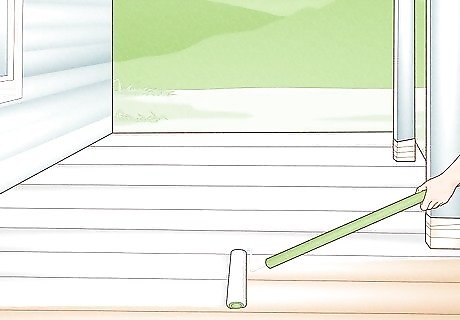
views
Preparing the Painting Area

Remove items from your front porch. Before painting, you’ll need to remove everything from the porch. If you have important things nearby like potted plants, outdoor furniture, or grills, you should cover them with a drop cloth to protect them from the paint.

Sweep away dust and debris. Sweep your front porch with a broom to get rid of dirt and dust. Try to get as much dirt out of the cracks between the boards as possible.

Hose down the surface. A high pressure garden hose or power washer works great for spraying down your porch with water. This should remove any remaining dirt and debris so you can have a clean surface on which to paint. For a concrete porch, scrub it thoroughly with a scrub brush, water, and a concrete cleaning chemical. Be sure to wear the appropriate protective gear to avoid dangerous contact with the chemical. Since wood is a porous surface, you want to wait for your porch to dry completely before attempting to paint. It can take up to 24 hours, especially in humid climates.

Sand and scrape your porch to remove any existing paint. If your porch is covered with old paint, you’ll need to remove that before applying a new coat. Use an orbital sander to sand the old paint off the surface of the porch. You can also use paint scrapers to get some of the old paint off. Wear a respirator when operating the sander to protect your lungs from debris. When you’re done sanding, clean up the dust and sand with a broom or vacuum so the porch is clean and smooth.

Tape areas you want to keep clean. Use painter’s tape to cover any places where do you not want the paint to touch. This should include where your porch touches your home. Use caution and a moderate amount of paint when painting near the taped areas so as not to get the paint underneath the tape.

Mix a Muriatic acid solution if you’re working on concrete that has never been painted. If you’re working on a concrete porch that has never been painted, you’ll need to etch it with a 5-10% Muriatic acid and water solution to help the primer and the paint adhere to the concrete. Dilute the muriatic acid with water per the bottle’s instructions. Use a stiff-bristled brush to scrub the Muriatic acid solution onto the porch. Let the acid sit on the concrete until it stops bubbling. Muriatic acid can cause severe burns and lung damage. Make sure you wear goggles, rubber gloves and boots, and read the safety instructions thoroughly before using this chemical.

Wash the concrete and vacuum the acid powder. Thoroughly wash the acid solution off the concrete with a pressure washer. Once it has dried, vacuum up the remaining powder created by the acid so that the primer and paint will adhere correctly to the concrete. The finished etching should give the concrete the texture of #1 or #2 sandpaper.
Priming and Painting Your Porch

Prime your porch with exterior primer. Use paint rollers to cover your porch with exterior primer. Start on the far end of the porch so you won’t walk on wet paint. Work from one end of the porch to the other until the entire porch is covered with a smooth, even coat. Use a paint brush to prime cracks or tight spaces. Watch out for falling leaves or bugs that could stick to the wet primer. Primer helps the paint stick to the surface of your porch.

Let the primer dry before applying a second coat. Drying time depends on which type of primer you’re using, but plan on waiting between 1 and 8 hours. Once you’ve waited the entire drying time, it’s time to apply a second coat of exterior primer in the same manner that you applied the first.

Apply the first coat of paint once the primer is dry. It’s crucial to allow the primer to dry completely so that your paint will last longer. Using a paint that’s specifically made for outdoor porches or floors, use paint rollers on extension poles to apply an even coat of paint to your porch. As with the primer, you can use a brush to paint hard-to-reach spots. Paint made specifically for floors or porches will stand up better to wear and tear than other paints. Some paint designed for porches contains grit for added traction. Make sure you choose a paint that’s tailored to either wood or concrete. Dark colors generally hide chips and stains easier than light-colored paint. Consider what kind of use your porch will get when choosing a color. Use darker colors of heavy-use areas.

Allow the paint to dry before applying a second coat. Let the first coat of paint dry completely before starting the second coat. Depending on what type of paint you’re using, this could take up to 8 hours. Once the drying is complete, apply a second coat of paint just as you did the first.

Apply sealant if you’re working on a concrete porch. Once your second coat of paint is completely dry, apply a final layer of sealant to help prevent water from seeping through the paint and ruining the paint job. This will also protect your concrete porch from sun damage.

Wait 2 days before walking on the porch. Waiting will ensure that you don’t walk on paint that is still tacky. Once your 2 days are up, you can replace your outdoor furniture and walk on the porch all you like!



















Comments
0 comment